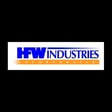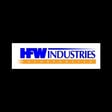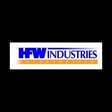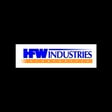Become a Creator today!Start creating today - Share your story with the world!
Start for free
00:00:00
00:00:01

Episode 17: Traction
Today we introduce Traction/EOS as part of a larger initiative to grow our business and further develop our people. Our goal is for HFW to be the best employer in the manufacturing industry, which will propel our business to future success. Traction is one way to help us cultivate this high-performance culture we are after.
Let me know if you would like to be on a future episode!
Transcript
Return of HFW Shop Talk Podcast
00:00:10
Speaker
All right. And welcome back to the HFW shop talk podcast. It's been a little while. It's been, I think almost three months, took a little bit of an inadvertent hiatus.
00:00:24
Speaker
But we are back today. We have a topic that I'm excited to dive into. And we've got a couple good episodes coming up over the next couple months. So excited to be back and apologize for the little bit of a break we took there.
Introduction to Traction
00:00:42
Speaker
So topic I want to talk about today is something that's been brewing really since last July and even before that, but we formally kicked it off last July. Um, and that is this, this whole idea, this whole, uh, topic called traction or EOS. You'll kind of hear either term used interchangeably.
00:01:10
Speaker
And before I get into what it is and what that involves, I just kind of want to explain what we've been doing. It's kind of been working in the background so far, and now today I'm formally unveiling it. So I wanted to dig into kind of explain the process that we've been going through so far.
00:01:29
Speaker
So, this is a process or a system that we kicked off with the management team last July. So, we've been running on it for the last eight months or so, working our way toward a year now, and then brought in the supervisors to have their own subset of this traction process in January.
00:01:55
Speaker
And so now that we've kind of brought in the leadership of the company, we want to formally unveil it to everyone and explain a little bit about what it is, what you can expect, and any changes that might come with that.
00:02:12
Speaker
So I'm introducing it today and my dad will have more about that in the coming weeks, which I'll get to.
Implementing Traction
00:02:21
Speaker
But you may have actually already noticed some relatively minor changes already. Again, as with a lot of the traction process, these things aren't going to be world altering. It's not going to be like you show up to work one day and the workplace is completely different. It's meant to be a gradual change to some of the ways we do things.
00:02:43
Speaker
And so what is traction? I've been babbling here already for almost three minutes. What is traction? What is it? It's essentially just a system. It's based on a book. And there's actually a whole series of books that we are more than happy to provide to anyone who's interested to learn more. There's actually a couple of different ones. And if you have any questions or are curious or want to learn more, let me know and we can have a conversation.
00:03:10
Speaker
But it's based on this book and the idea is most small businesses are running in some sort of chaos right. Somehow things get out the door bills get paid but there's no real system there's no.
00:03:31
Speaker
ability to forecast. It's a lot of firefighting day in and day out. Instead of focusing on the strategic and where we want to go, there's a lot of focus on just getting through that day. That's the way most small businesses work, and even large businesses too, really, if you think about it. But attractions focus on just small, usually family-owned businesses.
00:03:57
Speaker
And so what it does is help get everyone rowing in the same direction. And so the goal is to have everyone's dreams and aspirations and goals aligned. And how do you do that? Through clear objectives, communication, communicating the company's vision, the different metrics that we're tracking, our company's performance, and really tying our vision and our culture into the way the businesses
00:04:27
Speaker
And so again, these are things that you may have noticed already. We're doing some things a little bit different. We're trying some things that we haven't necessarily done in the past. And you're going to notice some of that, like I said, some of those things have already happened.
Aligning Company Goals
00:04:42
Speaker
They're not, again, huge things. And then there's going to be some changes coming up over the next couple months that you will start to hear more about.
00:04:52
Speaker
And again, the goal is get everyone rowing in the same direction, understanding how we get there and how we're going to reach success. And obviously success is a different
00:05:09
Speaker
Thing to each person and so one of the things with traction is to identify what success means to each person and how that can work how we can work collaboratively to achieve the success of the business and
00:05:25
Speaker
I guess to answer the question, why should we all care about the success of the business? The better HFW does, the better we can take care of each and every person and create the most fulfilling workplace going. That is really core to the traction process is
00:05:48
Speaker
making our business the very best place to work. Now, as we discussed, it's a two way street, right? We really view HFW as being a premier employer. And we need some very skilled talent to do that. And I think we have that. But we have to continue to expect
00:06:12
Speaker
a high level of performance and success in order to be a very, very best-in-class employer. It's really no different than a sports team. If you think about it, Josh Allen, to make an analogy that I think most people understand, Josh Allen, of course, makes a lot more money than a third-string quarterback. Do you even know the third-string quarterback of the bills? Most people aren't going to be able to name that guy offhand.
00:06:40
Speaker
Because the performance and so when you look at the different shops across Buffalo or across the country we definitely consider ourselves to be the I guess the the elite the Josh Allen tier of shops and so we want to pay people very well, but
00:06:57
Speaker
What comes with that obviously is the performance. There's going to be with the traction process more of this communication as to the metrics we're working toward. Those metrics themselves are going to be collaborative. You're not just going to show up and say, this is what we're hitting. It's really working with everyone to determine what is possible, where you want to go, and how we can get to where the company is trying to go collaboratively.
00:07:27
Speaker
And so I guess what can you expect, right? You know, I've been talking about this. It sounds great in theory. You know, what are the things that you can expect?
00:07:37
Speaker
Well, there's two things right off the bat that will be, I guess, concrete things that you'll notice right away. The first is very soon in the next couple of months, the supervisors are going to begin sitting down with each and every person and constructing a career development plan, or just really just a career check-in, right? If you're a senior guy, maybe it's not as much of a development plan, right? You're already fully developed and an extremely valuable player.
00:08:06
Speaker
But it's really just a career check-in, understanding what your goals and priorities are, where you want to go, and what we can do to help you get there. And again, I think it works well. If you're satisfied, if you know where you want to go, the business can plan for that. And we can mutually benefit from that understanding.
00:08:35
Speaker
a younger person's perspective, it really is more of a career development plan, which we've called it. But then for even our senior guys, just checking in, hey, what does the next five to 10 years look like for you? What does the next five to 10 years look like for the business?
00:08:50
Speaker
And that helps us plan. And we can understand what's important to you, what you're looking at, and then communicate what we're looking at, too, just so you know what's going on. You have a sense of how things are being done and why. And then also, most importantly, give your feedback to that and contribute. One thing that we've really focused on as a big part of Traction is having everyone's involvement in the process.
00:09:20
Speaker
Lot of the the the ideas and the ways we get better as a company come from the shop floor and That's why we've implemented a bunch of different things that were really in the beginning phases of rolling out But we have a job notes form for example I know I talked with a few of you guys about this the job notes form is anytime you have an idea or you say
00:09:46
Speaker
Well, if we did the job this way, instead of the way it's written on the sheet, it would save us a lot of time and money. I wonder if that'd be something useful. That's where the job notes sheet comes in handy. That then gets communicated to engineering, gets communicated to Peter, and it creates a record of that feedback.
00:10:12
Speaker
The best ideas have almost always come from the shop floor in one way or another and so You know, I've gotten a little bit on a tangent here, but it's all connected This is the these are the things we're trying to get more out of we're trying to take everyone's input and feedback to make hfw the best possible company and that's really What traction is trying to do as well?
Core Values and Traction Kickoff
00:10:36
Speaker
And so the second thing that will be upcoming as a result of our attraction process and that will involve everyone is my dad, Matt, will be giving a core values speech in the next week or two. And so what this is is kind of, I guess, the formal kickoff, if you will.
00:10:57
Speaker
where my dad discusses the core values that we've come up with that really encapsulate what we're about as a business and as a group of people. For everyone working at HFW, I don't think any of it should be a terrible surprise, hopefully.
00:11:14
Speaker
But it's just a way to, again, formally kick off what we're doing, explain the what and the why and the vision for what we want HFW to be. And then just, again, being the start of that feedback loop and keeping everyone in the know about the things that we're trying to do to take this company to the next level. And again, what's in it for each and every person to get to that next level?
00:11:41
Speaker
It's just, it comes down to a couple of things. One, obviously, the big one, the most important one is more money. There's more money available.
00:11:49
Speaker
as we get to that next level and we're a super successful business, it opens new opportunities and new positions and taking care of the people that have gotten us there. And then it also, it just makes HFW a better place to work. There's no confusion about what's expected. There's no second guessing, is this what they're looking for? I'm not really sure what the goal is here.
00:12:20
Speaker
The primary objective with Traction is providing that clarity. That's something that we're really trying to drive in the business is that clarity and that communication and really creating a team that is focused, is performance oriented, and wants to achieve some pretty badass things. I know and I can promise you that as we do that, each and every person will benefit.
Iterative Process and Feedback
00:12:49
Speaker
And so lastly, one thing I think you'll notice in general, you may have already noticed in some way or another, is that the traction process will provide more metrics and data sharing and how we are doing as a business to each and every person in the company.
00:13:06
Speaker
I think that's very important. I think it's important for everyone to know the score, to know what we're trying to do. And again, just understanding where we are, where we're trying to go, how we're going to get there, and how each and every person will benefit from that.
00:13:22
Speaker
So that's it thrown a lot at you in the span of 13 and a half minutes here. Um, you know, this is an iterative process. And what I mean by that is we're, we're kind of figuring it out as we go, making changes as needed. Everything we try as part of this process and just trying to grow the business and do things better is not going to work. Um, and you've probably noticed that. And so I guess on the one hand, um,
00:13:50
Speaker
give us some grace as we go through this. On the other hand, give us the feedback too. If it's not working, let us know. And we're going to try different things. And really, I just want to emphasize my genuine goal is to make HFW the best possible place to work. This process is one way to help do that. There's other objectives
00:14:11
Speaker
with the traction process. But one of the very top ones in my mind is making HFW and continuing HFW's legacy of being a good employer. Because I firmly believe that if we can be the best possible employer,
00:14:26
Speaker
Everything else will take care of itself. Our customers will be happy. Our people will be happy. And then the financial results will come with that.
Conclusion and Q&A
00:14:34
Speaker
And so we'll get into more of the specifics. And if anyone has questions, I'm very happy to talk about this. This is something that I spend a lot of time working on. I know I get the question, what do you do? Which is a great question because it varies day to day. This traction implementation has been a big part of my life
00:14:55
Speaker
almost the last year and it's something that I think can help. It's not the silver bullet. It's not going to get us to success as we see it or help us reach our goals overnight. It's one piece in a puzzle to get us to that next level and to drive the continued success of HFW.
00:15:17
Speaker
So again, I'll close very willing to answer questions or talk about it or just discuss more. If you have any questions, let me know. And until then, I will see you on the next podcast. Thank you.












